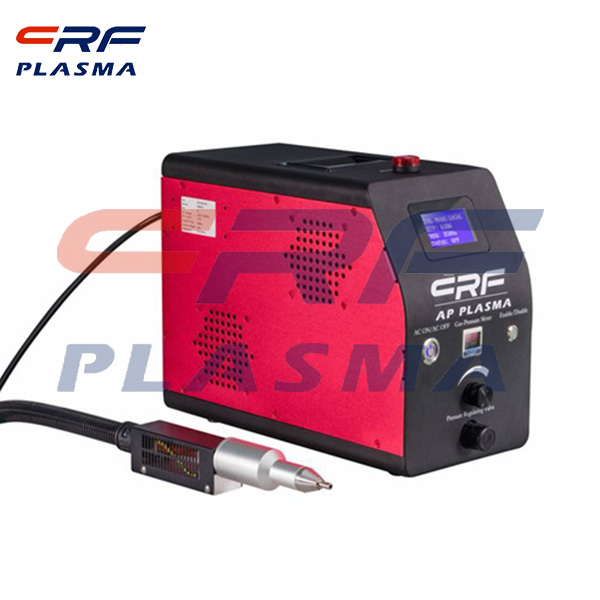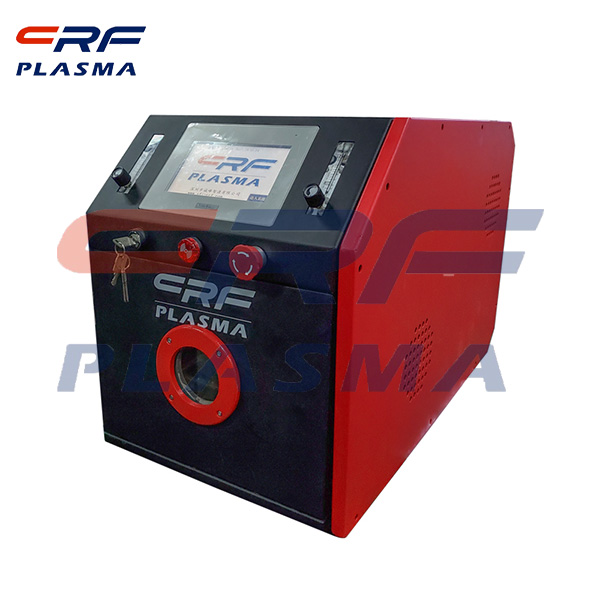
Welcome to Shenzhen Sing Fung Intelligent Manufacturing Co., Ltd.
E-mail:shaobo@sfi-crf.com
How plasma surface treatment works-CRF PLASMA
- Categories:Technical Support
- Author:plasma cleaning machine-surface treatment equipment-CRF plasma machine-Sing Fung Intelligent Manufacturing
- Origin:
- Time of issue:2020-10-09
- Views:
(Summary description)A plasma is a collection of electrically neutral substances composed of ions, electrons and neutral particles. During plasma surface treatment, the plasma transmits its energy to the molecules and atoms on the surface of the material when it collides with the surface of the material, resulting in a series of physical and chemical reactions. By injecting particles or gases into the surface of the material, it can cause collision, scattering, excitation, rearrangement, isomerization, defect, crystallization and amorphous, so as to change the surface properties of the material. 1. Etching effect of plasma surface treatment on material surface: Under physical action, a large number of ions, excited molecules, free radicals and other active particles in the plasma will act on the surface of solid samples, which can remove the original pollutants and impurities on the surface. This process also produces etching, which can make the surface of the sample rough, forming many tiny pits, increasing the roughness ratio of the sample surface, and improving the adhesion and wetting properties of the solid surface. 2. Effects of plasma surface treatment on activation bond energy and cross-linking: The particle energy in the plasma is between 0 and 20eV, while most of the bond energy in the polymer is between 0 and 10eV. Therefore, after plasma surface treatment ACTS on the solid surface, the original chemical bonds on the solid surface can be broken, creating a new reaction atmosphere. Free radicals in the plasma can form a network crosslinking structure with these bonds, which greatly activates the surface activity. 3. Plasma surface treatment can form new functional groups: When plasma surface treatment is carried out, introducing reactive gas into discharge gas will produce complex chemical reactions on the surface of activated material. In this process, new functional groups can be introduced into the material surface, such as hydrocarbon group, amino group, carboxyl group, etc. These new functional groups are some active groups, which can significantly improve the activity of the material surface. The principle of plasma surface treatment is mainly to use the active particles in the plasma for "activation", so as to achieve the treatment effect of removing the pollutants on the material surface. Plasma surface treatment usually involves the following reaction processes: (1) Firstly, the inorganic gas is excited into a plasma state; (2) The gaseous phase substances are adsorbed on the solid surface through the action; (3) The adsorbed substances react with molecules on the solid surface to form product molecules; (4) The product molecules are then analyzed to form the gas phase, so as to achieve the effect of the reaction residue off the surface.
How plasma surface treatment works-CRF PLASMA
(Summary description)A plasma is a collection of electrically neutral substances composed of ions, electrons and neutral particles. During plasma surface treatment, the plasma transmits its energy to the molecules and atoms on the surface of the material when it collides with the surface of the material, resulting in a series of physical and chemical reactions. By injecting particles or gases into the surface of the material, it can cause collision, scattering, excitation, rearrangement, isomerization, defect, crystallization and amorphous, so as to change the surface properties of the material.
1. Etching effect of plasma surface treatment on material surface:
Under physical action, a large number of ions, excited molecules, free radicals and other active particles in the plasma will act on the surface of solid samples, which can remove the original pollutants and impurities on the surface. This process also produces etching, which can make the surface of the sample rough, forming many tiny pits, increasing the roughness ratio of the sample surface, and improving the adhesion and wetting properties of the solid surface.
2. Effects of plasma surface treatment on activation bond energy and cross-linking:
The particle energy in the plasma is between 0 and 20eV, while most of the bond energy in the polymer is between 0 and 10eV. Therefore, after plasma surface treatment ACTS on the solid surface, the original chemical bonds on the solid surface can be broken, creating a new reaction atmosphere. Free radicals in the plasma can form a network crosslinking structure with these bonds, which greatly activates the surface activity.
3. Plasma surface treatment can form new functional groups:
When plasma surface treatment is carried out, introducing reactive gas into discharge gas will produce complex chemical reactions on the surface of activated material. In this process, new functional groups can be introduced into the material surface, such as hydrocarbon group, amino group, carboxyl group, etc. These new functional groups are some active groups, which can significantly improve the activity of the material surface.
The principle of plasma surface treatment is mainly to use the active particles in the plasma for "activation", so as to achieve the treatment effect of removing the pollutants on the material surface. Plasma surface treatment usually involves the following reaction processes:
(1) Firstly, the inorganic gas is excited into a plasma state;
(2) The gaseous phase substances are adsorbed on the solid surface through the action;
(3) The adsorbed substances react with molecules on the solid surface to form product molecules;
(4) The product molecules are then analyzed to form the gas phase, so as to achieve the effect of the reaction residue off the surface.
- Categories:Technical Support
- Author:plasma cleaning machine-surface treatment equipment-CRF plasma machine-Sing Fung Intelligent Manufacturing
- Origin:
- Time of issue:2020-10-09 09:49
- Views:
How plasma surface treatment works:
A plasma is a collection of electrically neutral substances composed of ions, electrons and neutral particles. During plasma surface treatment, the plasma transmits its energy to the molecules and atoms on the surface of the material when it collides with the surface of the material, resulting in a series of physical and chemical reactions. By injecting particles or gases into the surface of the material, it can cause collision, scattering, excitation, rearrangement, isomerization, defect, crystallization and amorphous, so as to change the surface properties of the material.
1. Etching effect of plasma surface treatment on material surface:
Under physical action, a large number of ions, excited molecules, free radicals and other active particles in the plasma will act on the surface of solid samples, which can remove the original pollutants and impurities on the surface. This process also produces etching, which can make the surface of the sample rough, forming many tiny pits, increasing the roughness ratio of the sample surface, and improving the adhesion and wetting properties of the solid surface.
2. Effects of plasma surface treatment on activation bond energy and cross-linking:
The particle energy in the plasma is between 0 and 20eV, while most of the bond energy in the polymer is between 0 and 10eV. Therefore, after plasma surface treatment ACTS on the solid surface, the original chemical bonds on the solid surface can be broken, creating a new reaction atmosphere. Free radicals in the plasma can form a network crosslinking structure with these bonds, which greatly activates the surface activity.
3. Plasma surface treatment can form new functional groups:
When plasma surface treatment is carried out, introducing reactive gas into discharge gas will produce complex chemical reactions on the surface of activated material. In this process, new functional groups can be introduced into the material surface, such as hydrocarbon group, amino group, carboxyl group, etc. These new functional groups are some active groups, which can significantly improve the activity of the material surface.
The principle of plasma surface treatment is mainly to use the active particles in the plasma for "activation", so as to achieve the treatment effect of removing the pollutants on the material surface. Plasma surface treatment usually involves the following reaction processes:
(1) Firstly, the inorganic gas is excited into a plasma state;
(2) The gaseous phase substances are adsorbed on the solid surface through the action;
(3) The adsorbed substances react with molecules on the solid surface to form product molecules;
(4) The product molecules are then analyzed to form the gas phase, so as to achieve the effect of the reaction residue off the surface.

Scan the QR code to read on your phone

TEL:0755-3367 3020 / 0755-3367 3019

E-mail:sales-sfi@sfi-crf.com

ADD:Mabao Industrial Zone, Huangpu, Baoan District, Shenzhen


















